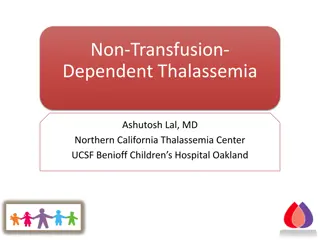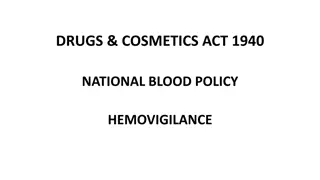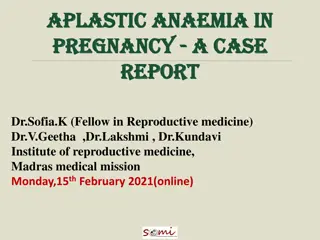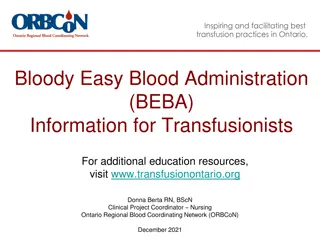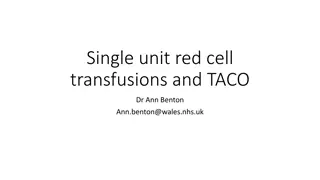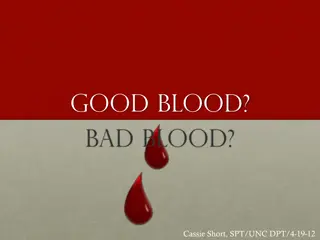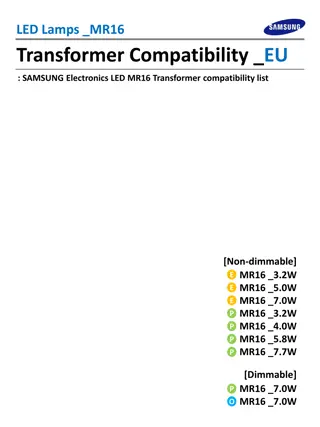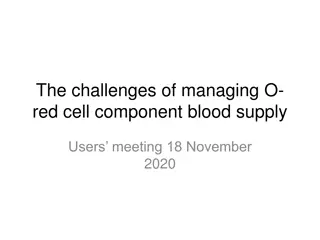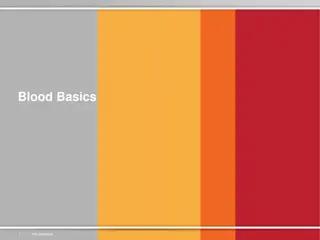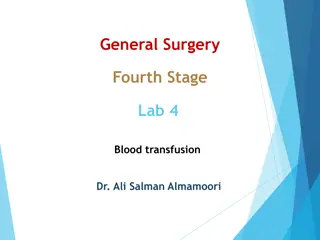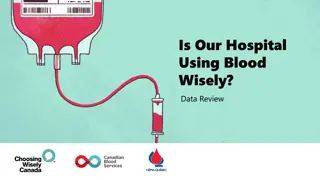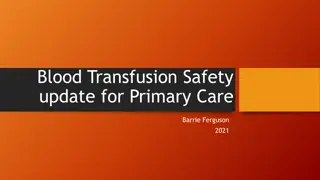Understanding Blood Compatibility for Safe Transfusions
This presentation delves into the critical topic of blood compatibility for safe transfusions, covering aspects such as ABO and Rh blood groups, clinically significant antibodies, and potential incompatibilities. The session aims to enhance understanding of antigens, antibodies, and the risks of mismatched transfusions through patient cases and visual aids. Key points include responsibilities of transfusionists, risks of incompatible transfusions leading to hemolysis, and the importance of confirming blood compatibility.
Download Presentation

Please find below an Image/Link to download the presentation.
The content on the website is provided AS IS for your information and personal use only. It may not be sold, licensed, or shared on other websites without obtaining consent from the author. Download presentation by click this link. If you encounter any issues during the download, it is possible that the publisher has removed the file from their server.
E N D
Presentation Transcript
The Elephant in the Transfusionists Skill Set: Understanding Compatibility for Transfusion Safety Donna Berta RN, BScN Clinical Project Coordinator Nursing Ontario Regional Blood Coordinating Network (ORBCoN) March 27, 2024
Speaker Disclosure No commercial product conflicts of interest to declare Transfusion Transmitted Injuries Surveillance System, member Education Committee Using Blood Wisely initiative, member nursing education development Canadian Society of Transfusion Medicine, member Standards Committee
Pre Transfusion Knowledge Question 1 Paramedics arrive in ED with Emma, a 21-year-old female trauma patient. She is unresponsive, being intubated, unstable & bleeding. Lab tests are pending. Blood, 4 units RBC & 4 units plasma (FP), is ordered. The safest blood for this patient, Emma is: a) Group O, Rh positive RBC and group O FP. b) Group O, Rh negative RBC and group O FP. c) Group O, Rh positive RBC and group AB FP. d) Group O, Rh negative RBC and group AB FP.
Pre Transfusion Knowledge Question 2 An RBC unit crossmatched, compatible is safe for transfusion when: a) The ABO antigens on the red blood cells in the unit of blood will not be hemolysed by ABO antibodies in the patient s plasma. b) The ABO antigens on the red blood cells in that unit of blood will be hemolysed by ABO antibodies in the patient s plasma. c) The ABO antibodies on the red blood cells in the unit of blood will not be hemolysed by ABO antigens in the patient s plasma. d) The ABO antibodies on the red blood cells in the unit of blood will be hemolysed by ABO antigens in the patient s plasma.
The Elephant in the Transfusionists Skill Set: Understanding Compatibility for Transfusion Safety Objectives: To recognize and understand the antigens & antibodies in the ABO & Rh(D) blood groups, the clinically significant antibodies, and the potential for incompatibility (patient/component). To increase confidence in this knowledge by evaluating patient cases. Outline: Blood Compatibility ABO Blood Group System Rh(D) Antigen, Rh Blood Group System Clinically Significant Antibodies Patient Cases with Blood Compatibility Check Visual Aid Take Home Messages/Summary
Blood Compatibility (1) Transfusionist: responsibility & accountability for confirming blood compatibility. Refers to the ability of one individual's blood to be transfused safely (without an adverse reaction) into another individual's body. An incompatible transfusion can lead to hemolysis. Hemolysis is the destruction of red blood cells & subsequent leakage (hemoglobin) into intravascular (circulation, main blood vessels) or extravascular (reticuloendothelial system) space. Both immune (antigen-antibody mismatch) and non-immune (thermal, osmotic, or mechanical injury to blood products) mediated hemolytic transfusion reactions can occur. Most hemolytic transfusion reactions are benign, however life- threatening anemia, coagulopathy & renal failure can ensue.
Blood Compatibility (2) An antigen is a substance that can cause an immune system reaction. It is a marker or identifier (name badge) that indicates if a substance is foreign or not foreign (does not belongs or belongs) in your body. An antibody is a protein that the immune system produces to attack & fight foreign antigens (protector). Determined by the presence or absence of antigens & antibodies (in the blood to be transfused & the patient s blood). Blood group antigens are categorized into blood group systems (July 2023, 45 blood group systems are known) based on genetic origins. Antibody: in the plasma Antigen: on exterior surface of red blood cell For transfusion, ABO blood group system is most significant, with Rh blood group system, Rh(D) antigen second in importance.
ABO Blood Group System (1) GROUP AB GROUP A GROUP O GROUP B ABO Antibodies are naturally acquired, starting at 4 months of age. If, the antigen is present on the surface of the red blood cells, then the corresponding antibody will NOT be in the plasma. If, the antigen is NOT present on the surface of the red blood cells, then the corresponding antibody will be in the plasma.
Learning Review 1 For blood group O, no ABO antigens are on the exterior surface of red blood cells. What antibody(ies) will be in the plasma? a) Anti-A antibody. b) Anti-B antibody. c) Both anti-A and anti-B antibodies. d) No antibodies.
ABO Blood Group System (1) GROUP AB GROUP A GROUP O GROUP B ABO Antibodies are naturally acquired, starting at 4 months of age. If, the antigen is present on the surface of the red blood cells, then the corresponding antibody will NOT be in the plasma. If, the antigen is NOT present on the surface of the red blood cells, then the corresponding antibody will be in the plasma.
Learning Review 2 For blood group AB, antigens A and B are on the exterior surface of red blood cells. What antibody(ies) will be in the plasma? a) Anti-A antibody. b) Anti-B antibody. c) Both anti-A and anti-B antibodies. d) No antibodies.
ABO Blood Group System (1) GROUP AB GROUP A GROUP O GROUP B ABO Antibodies are naturally acquired, starting at 4 months of age. If, the antigen is present on the surface of the red blood cells, then the corresponding antibody will NOT be in the plasma. If, the antigen is NOT present on the surface of the red blood cells, then the corresponding antibody will be in the plasma. cause immediate intravascular red blood cell destruction, may lead to severe/fatal hemolysis.
ABO Blood Group System (2) Compatibility is determined by the presence or absence of antigens &antibodies (in the blood to be transfused & the patient s blood). Red blood cells: Antigen(s) Plasma: Antibody(ies) TransfusingRBC: ensure the patient s plasma antibodies will not hemolyze the transfused RBC (the RBC unit s red blood cells do not have corresponding antigen on their surface). Transfusing FP: ensure the antibodies in the FP will not hemolyse the patient s red blood cells (patient s red blood cells do not have the corresponding antigen on their surface). Transfused platelets: should be ABO compatible with patient s red blood cells (platelets are suspended in donor plasma & also contain a few red blood cells). If platelets are in short supply, TML policy re: blood group substitution.
ABO Blood Group System (3) RBC unit Group A transfused to patient Group A (microscope, schematic) RBC unit Group B transfused to patient Group A (microscope, schematic)
Rh(D) Antigen, Rh Blood Group System (1) Rh(D) is clinically the most important of the 54 antigens in the Rh blood group system. GROUP Rh(D) POSITIVE GROUP Rh(D) NEGATIVE
Rh(D) Antigen, Rh Blood Group System (2) Anti-D Antibody Anti-D antibody is NOT naturally occurring and is NOT in the plasma of: o Rh(D) positive patients o Rh(D) negative patients UNLESS exposed to the D antigen, and then anti-D antibody may be produced. Rh(D) negative individuals can be exposed to the D antigen (and then may produce anti-D antibody) through: o Transfusion of Rh(D) positive RBC o Transfusion of Rh(D) positive platelets (platelets contain small amounts of red blood cells) o Pregnancy/delivery of an Rh(D) positive fetus Anti D antibody can cause severe immediate or delayed hemolysis. Rh(D) positive blood should not be transfused to a patient with anti D. Anti-D: most common cause of severe Hemolytic Disease of the Fetus & Newborn (HDFN). Rh immune globulin (RhIG) prophylaxis, used since late1960 s.
Rh(D) Antigen, Rh Blood Group System (3) Rh(D) positive patients: can be transfused blood that is Rh(D) positive or Rh(D) negative. Rh(D) negative patients: ideally should be transfused blood that is Rh(D) negative to avoid producing the anti-D antibody. Rh(D) negative females of child-bearing age/potential (to avoid producing the anti-D antibody and risk of HDFN) : o should be transfused blood that is Rh(D) negative. o if Rh(D) positive platelets are transfused (re: platelet supply), Rh immunoglobulin (RhIG) is required. For FP transfusion: Rh(D) blood group is not relevant (plasma has no red blood cells, i.e., no antigens)
Clinically Significant Antibodies (1) In addition to antigens A, B, and D human red blood cells have many other antigens on their surface. If exposed to foreign red blood cell antigens via pregnancy or transfusion, antibodies against these antigens may be produced. Clinically Significant Antibodies: If a patient forms these antibodies, then hemolysis of transfused RBC unit that has the corresponding antigen on the red blood cells can occur. NOTE: For females of child-bearing potential, providing Kell negative (K-) RBC decreases the incidence of K-immunized pregnancies (and potential HDFN). In Canada this is established practice, except in emergency transfusion scenarios.
Clinically Significant Antibodies (2) Group & Screen Test - antibody screen (antibody detection test): TML tests the serum (plasma part of patient blood sample) to either rule out or identify the clinically significant antibodies. If all clinically significant antibodies are ruled out, the antibody screen is reported as negative. If clinically significant antibody(ies) are identified (red blood cell sensitization/alloimmunization), compatible RBC units for patient transfusion must be negative for the corresponding antigen(s). (e.g., anti-c and anti-FyA identified in the plasma of the patient s blood sample, then RBC units for transfusion must be antigens c- and FyA-). TML maintains meticulous transfusion history records; they are consistently checked.
Clinically Significant Antibodies (3) Anamnestic/Recall Response: Clinically significant antibody levels in the patient s plasma will decrease over time and may become non-detectable. The anamnestic/recall response refers to when a second exposure to the same antigen occurs, the antibody response is typically faster, much more sustained & antibody levels are higher. Anti-JkA and anti-JkB (Kidd blood group system) are notable. If clinically significant antibody(ies) identified, patient should be counselled, provided antibody card ; option medical alert bracelet. For RBC transfusion, when feasible, ask patients/their family (and follow up with TML as indicated). o Have they had previous transfusion? o If so, did they experience any side effects/reactions?
Summary: Blood Compatibility Checks ABO Blood Groups (if antigen present, then antibody absent; if antigen absent then antibody present; ABO antibodies are naturally acquired, starting at 4 months of age). Blood Group Population Frequency ABO Antigen(s) - red blood cell surface ABO Antibody(ies) - plasma O 45% none anti-A, anti-B A 40% A Anti-B B 11% B Anti-A AB 4% AB none Rh(D) Blood Group (antigen present or absent; Rh(D) antibody is NOT naturally occurring). Blood Group Population Frequency Rh(D) Antigen - red blood cell surface Rh(D) Antibody(ies) - plasma Rh(D) positive 85% D none Rh(D) negative 15% none None; if exposed to Rh(D) antigen (transfusion or pregnancy), then anti-D may be produced. Clinically significant antibodies (antibody screen/detection test): anti-D, anti-C, anti-c, anti-E, anti-e, anti-K, anti-k, anti-JkA anti-JkB (Kidd), anti-FyA anti-FyB (Duffy), anti-S, anti-s.
Summary: Patient Patient s group & screen test RESULTS Transfusion Medicine Lab Sample Outdate Blood Group Confirmation ABO, Rh(D) Group Antibody Screen Antibody Identification REVIEW Comment Direct Antiglobulin Test 2021/05/01 11:30 2021/05/04 Blood group confirmed. A POS # POSITIVE anti-K REVIEW Comment Negative
Summary: RBC unit Blood donor/blood unit {Canadian Blood Services (CBS)} group & screen test Phenotype: Refers to which antigens are detectable on the red blood cells. Is noted on the CBS label if the donor is antigen negative (the red blood cells in that unit do not have that antigen on their surface and the unit would be compatible for a patient with that antibody).
Blood Compatibility Check Visual Aid RBC Transfusion Blood Compatibility - RBC Transfusion *Antigen(s) on exterior surface of red blood cell *Antibody(ies) in plasma ** Females of childbearing age/potential = Compatibility Check RBC unit Patient ABO Blood Group ABO Antigen(s) ABO Antibody(ies) Rh(D) Blood Group Rh(D) Antigen ** Rh(D) Antibody Clinically Significant Antibody(ies) Antigen(s) Negative ** * Ensure the patient s plasma antibodies will not hemolyze the transfused RBC unit (the RBC unit red blood cells do not have corresponding antigen on their surface).
Patient Case 1 Question Wilma, an 80-year-old female post hip fracture surgery, is SOB when up with physio & Hb is 69 g/L. A 1-unit RBC transfusion is ordered. Wilma sgroup & screen test: group O, Rh positive, antibody screen negative. TML issues RBC unit: group A, Rh positive, phenotype no information.
Patient Case 1 Compatibility Check Wilma sgroup & screen test: group O, Rh positive, antibody screen negative. TML issues RBC unit: group A, Rh positive, phenotype no information. Select the most correct statement. a) This transfusion is compatible because Wilma has no antigens on her red blood cells (group O) and the RBC unit s red blood cells have A antigen (group A). b) This transfusion is compatible because Wilma & the RBC unit are both Rh positive. c) This transfusion is incompatible because Wilma has both anti-A and anti-B antibodies in her plasma (group O) & the RBC unit s red blood cells have A antigen (group A). d) This transfusion is incompatible because the RBC unit has no phenotype information. A A O anti-A & anti-B Pos Pos D D No N/A Neg
Patient Case 2 Question Betty, a 32-year-old female, is admitted post successful endoscopy to treat a bleeding ulcer. Her Hb is 62 g/L. A 1-unit RBC transfusion is ordered. Betty sgroup & screen test: group B, Rh negative, antibody screen negative. TML issues RBC unit: group O, Rh negative, phenotype c-, FyA-.
Patient Case 2 Compatibility Check Betty s group & screen test: group B, Rh negative, antibody screen negative. TML issues RBC unit: group O, Rh negative, phenotype c-, FyA-. Select the most correct statement. a) This transfusion is compatible because Betty has anti-A antibody in her plasma (group B) & the RBC unit s red blood cells have no antigens (group 0). b) This transfusion is compatible because Betty & the RBC unit are both Rh negative. c) This transfusion is compatible because Betty has a negative antibody screen. d) This transfusion is not best practice for a non-urgent transfusion because the RBC unit s phenotype is not K- and Betty is of childbearing age/potential. O B none anti-A Neg Neg none none No c-, FyA- Neg
Patient Case 3 Question Fred, a 62-year-old male, is in the OR undergoing re-do aortic valve replacement surgery. His Hb is 70 g/L. A 1-unit RBC transfusion is ordered. Fred sgroup & screen test: group AB, Rh positive, antibody screen positive: anti-K, anti-JkA antibodies. TML issues RBC unit: group AB, Rh negative, phenotype no information.
Patient Case 3 Compatibility Check Fred sgroup & screen test: group AB, Rh positive, antibody screen positive: anti-K, anti- JkA antibodies. TML issues RBC unit: group AB, Rh negative, phenotype no information. Select the most correct statement. a) This transfusion is compatible because Fred has no ABO antibodies in his plasma (group AB) & the RBC unit s red blood cells have antigens A and B (group AB). b) This transfusion is incompatible because Fred has anti-K, anti-JkA antibodies in his plasma & the RBC unit s phenotype is not K-, JkA- (the RBC unit s red blood cells may have K and JkA antigens). c) This transfusion is incompatible because Fred s red blood cells have the D antigen and the RBC unit s red blood cells do not have the D antigen. d) This transfusion is acceptable because the RBC unit group AB, Rh negative is rare, expires soon, & should not be wasted. AB A, B AB none Neg Pos D none No NA anti-K, anti-JkA
Blood Compatibility Check Visual Aid FP Transfusion Blood Compatibility - FP Transfusion *Antigen(s) on exterior surface of red blood cell *Antibody(ies) in plasma = Compatibility Check FP unit Patient ABO Blood Group ABO Antigen(s) ABO Antibody(ies) *Ensure the antibodies in the FP unit will not hemolyse the patient s red blood cells (patient s red blood cells do not have the corresponding antigen on their surface). ** Rh(D) blood group is not relevant for FP (plasma has no red blood cells, i.e., no antigens).
Patient Case 4 Question Barney, a 22-year-old male, is a trauma patient in the ED. Massive Hemorrhage Protocol has been ordered. Initially he received group O, Rh positive RBC, and group AB FP. His group & screen test is now completed. FP transfusion is requested. Barney sgroup & screen test: group A, Rh positive, antibody screen negative. TML issues FP units: group AB.
Patient Case 4 Compatibility Check Barney sgroup & screen test: group A, Rh positive, antibody screen negative. TML issues FP units: group AB. Select the most correct statement. a) Barney could be transfused group B FP (anti-A antibody) as he has A antigen on his red blood cells (group A). b) Barney could be transfused group A FP (anti-B antibody) as he has A antigen on his red blood cells (group A). c) Barney could be transfused group O FP (anti-A & anti-B antibodies) as he has A antigen on his red blood cells (group A). d) Barney must be transfused only group AB FP (no ABO antibodies) as he has A antigen on his red blood cells (group A). AB A A none
Blood Compatibility Check Visual Aid Platelet Transfusion Blood Compatibility - Platelet Transfusion *Antigen(s) on exterior surface of red blood cell *Antibody(ies) in plasma ** Females of childbearing age/potential = Compatibility Check Platelet Patient ABO Blood Group ABO Antigen(s) ABO Antibody(ies) Rh(D) Blood Group Rh(D) Antigen ** Rh(D) Antibody *Transfused platelets should be ABO compatible with patient s red blood cells (platelets are suspended in donor plasma). Platelet components also contain a few red blood cells. If platelets are in short supply, TML policy re: ABO group substitution. **For Rh(D) negative females of childbearing age/potential, if Rh(D) positive platelets are transfused (re: platelet supply), Rh immunoglobulin (RhIG) is required.
Patient Case 5 Question Pebbles, a 33-year-old female, is undergoing induction chemotherapy for acute leukemia. Her clinical course is proceeding as anticipated. Today her platelet count is 8 x109/L. A 1-dose platelet transfusion is ordered. Pebbles group & screen test: group A, Rh negative, antibody screen negative. TML issues Platelet unit: group A, Rh positive.
Patient Case 5 Compatibility Check Pebbles group & screen test: group A, Rh negative, antibody screen negative. TML issues Platelet unit: group A, Rh positive. Select all the correct statements. a) Pebbles could be transfused group A platelets (plasma has anti-B antibody) as she has A antigen on her red blood cells (group A). b) The platelets are Rh positive, and Pebbles is Rh negative, she should receive RhIG . This is to prevent Pebbles from producing anti-D antibody. c) Pebbles could be transfused group O platelets (plasma has anti-A & anti-B antibodies) as she has A antigen on her red blood cells (group A). d) Pebbles could be transfused group AB platelets (plasma has no ABO antibodies) as she has A antigen on her red blood cells (group A). A A A anti-B Pos D Neg none No
The Elephant in the Transfusionists Skill Set: Understanding Compatibility for Transfusion Safety Take Home Messages Transfusion safety is teamwork! Confirming compatibility is one aspect of transfusion safety. Confirming compatibility is a transfusionist responsibility & accountability. Compatibility starts with the group & screen blood sample. Antigens (name badge) are on red blood cells. Antibodies (protectors) are in the plasma. Clinically significant antibodies (troublemakers), especially anti-D and anti-K, must be assessed. Respect patient identification & blood labels. When in doubt, refer to the Compatibility Table or call TML.
Post Transfusion Knowledge Question 1 Paramedics arrive in ED with Emma, a 21-year-old female trauma patient. She is unresponsive, being intubated, unstable & bleeding. Lab tests are pending. Blood, 4 units RBC & 4 units plasma (FP), is ordered. The safest blood for this patient, Emma is: a) Group O, Rh positive RBC and group O FP. b) Group O, Rh negative RBC and group O FP. c) Group O, Rh positive RBC and group AB FP. d) Group O, Rh negative RBC and group AB FP.
Post Transfusion Knowledge Question 2 An RBC unit crossmatched, compatible is safe for transfusion when: a) The ABO antigens on the red blood cells in the unit of blood will not be hemolysed by ABO antibodies in the patient s plasma. b) The ABO antigens on the red blood cells in that unit of blood will be hemolysed by ABO antibodies in the patient s plasma. c) The ABO antibodies on the red blood cells in the unit of blood will not be hemolysed by ABO antigens in the patient s plasma. d) The ABO antibodies on the red blood cells in the unit of blood will be hemolysed by ABO antigens in the patient s plasma.
Acknowledgements The Ontario Regional Blood Coordinating Network (ORBCoN) gratefully acknowledges funding support provided by the Ontario Ministry of Health. The views expressed in this presentation are those of the authors and of ORBCoN and do not necessarily reflect those of the Ontario Ministry of Health or the Government of Ontario. Many thanks to my ORBCoN and Transfusion Medicine family for their ongoing mentorship and support.
References (1) Callum JL, Pinkerton PH, Lin Y, Cope S, Karkouti K, Lieberman L, Pendergrast JM, Robitaille N, Tinmouth AT, Webert KE. Bloody easy 5.1 blood transfusions, blood alternatives and transfusion reactions a guide to transfusion medicine. 5th ed. Toronto: Ontario Regional Blood Coordinating Network; 2022 [revised 2023; cited 2024 Mar 18]. 145p. Available from: https://transfusionontario.org/en/category/bloody-easy-e-tools-publications/bloody-easy-for-healthcare-professionals/ Canadian Blood Services (CBS). Circular of information [Internet]. Ottawa (CA); CBS; 2023 [cited 2024 Mar 18]. Available from: https://www.blood.ca/en/hospital-services/products/component-types/circular-information Canadian Society for Transfusion Medicine (CA). Standards for hospital transfusion services. Markham ON; 2021 Dec; cited 2024 Mar 18. 110 p. Report No.: Version 5. Available from: http://www.transfusion.ca/Resources/Standards Daniels, G. Human Blood Group Systems. In: Murphy MF, Roberts DJ, Yazer MH, editors. Practical Transfusion Medicine [Internet]. Hoboken, New Jersey (US): John Wiley & Sons Inc; 2017 [cited 2024 Mar 18]. chapter 3. Available from: https://doi-org.libaccess.lib.mcmaster.ca/10.1002/9781119129431.ch3 Drews S, Khandelwal A, Goldman M, Devine D. Donor selection, donor testing and pathogen reduction. In: Khandelwal A, Abe T, editors. Clinical Guide to Transfusion [Internet]. Ottawa (CA): Canadian Blood Services; 2021 [cited 2024 Mar 18]. Chapter 6. Available from: https://professionaleducation.blood.ca/en/transfusion/clinical-guide/donor-selection-donor- testing-and-pathogen-reduction Issitt PD, Anstee DJ. Applied blood group serology 4th edition. Durham (North Carolina USA): Montgomery Scientific Publications; 1998. 1232p. Journal Compilation. Introduction to blood transfusion: donor to recipient. In: Armstrong BC, Wilkinson R, Goldman M, editors. International Society of Blood Transfusion Science Series. Vox Sanguinis [Internet]. 2020 [cited 2024 Mar 18];15(S1):1-333. Available from: https://doi.org/10.1111/voxs.12588
References (2) Klein HG, Anstee DJ. Haemolytic Transfusion Reactions In: Klein HG, Anstee DJ, Mollison PL, editors. Mollison's Blood Transfusion in Clinical Medicine [Internet]. Hoboken, New Jersey (US): John Wiley & Sons Inc; 2014 [cited 2024 Mar 18]. Chapter 11. Available from: https://doi-org.libaccess.lib.mcmaster.ca/10.1002/9781118689943.ch11 Ontario Regional Blood Coordinating Network. Bloody easy blood administration. version 3. Toronto: Ontario Regional Blood Coordinating Network; 2020 [cited 2024 Mar 18]. 146p. Available from: https://transfusionontario.org/en/category/bloody-easy-e-tools-publications/bloody-easy-blood-administration/ Ontario Regional Blood Coordinating Network. Provincial massive hemorrhage toolkit [Internet]. Toronto ON; Ontario Regional Blood Coordinating Network; 2020 Jul [cited 2024 Mar 18]. Available from: https://transfusionontario.org/wp- content/uploads/2023/02/MHP_Toolkit_v2.pdf Rout P, Harewood J, Ramsey A, Master SR. Hemolytic Transfusion Reaction. In: StatPearls [Internet]. Treasure Island (FL): StatPearls Publishing; 2023 [cited 2024 Mar 18]. Available from: https://www.ncbi.nlm.nih.gov/books/NBK448158/ Ruby KN, Harm SK, Dunbar NM. Risk of ABO-incompatible plasma from non-ABO-identical components. Transfusion Medicine Reviews [Internet]. 2021 [cited Mar 18];35(4):118 22. Available from: http://resolver.scholarsportal.info.libaccess.lib.mcmaster.ca/resolve/08877963/v35i0004/118_roapfnc.xml Tormey CA, Hendrickson JE. Transfusion-related red blood cell alloantibodies: induction and consequences. Blood, The Journal of the American Society of Hematology [Internet]. 2019 [cited Mar 18];133(17):1821-30. Available from: https://ashpublications.org/blood/article/133/17/1821/275904/Transfusion-related-red-blood-cell-alloantibodies
The Elephant in the Transfusionists Skill Set: Understanding Compatibility for Transfusion Safety Email: bertad@mcmaster.ca







